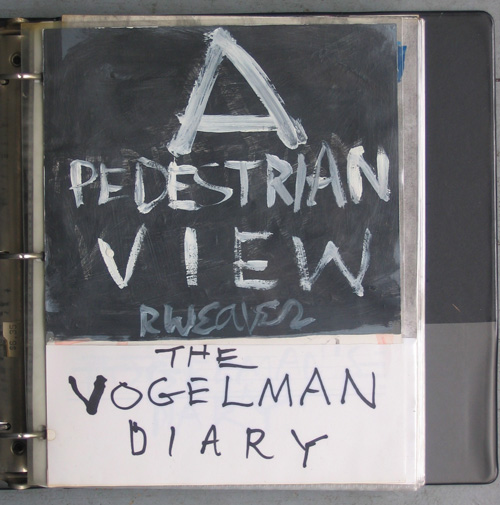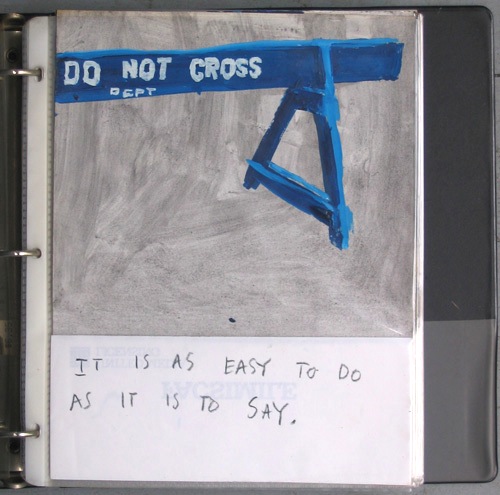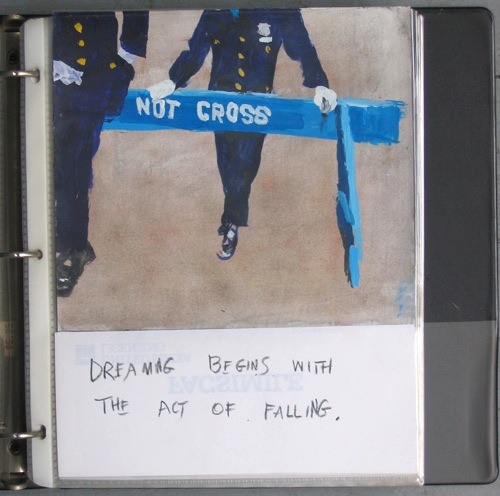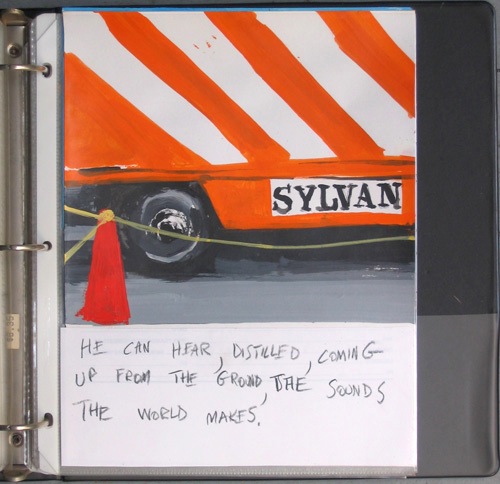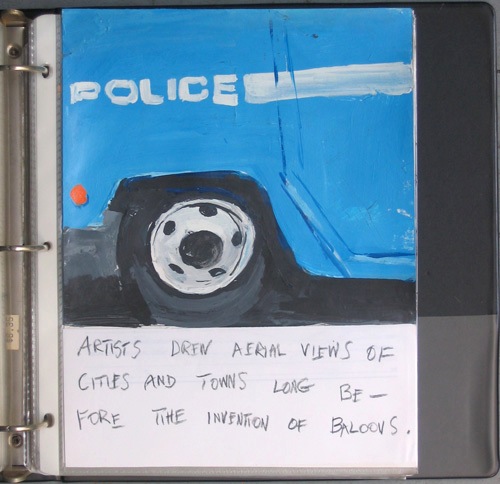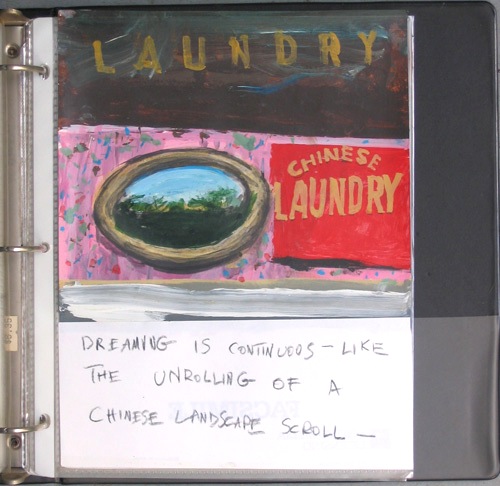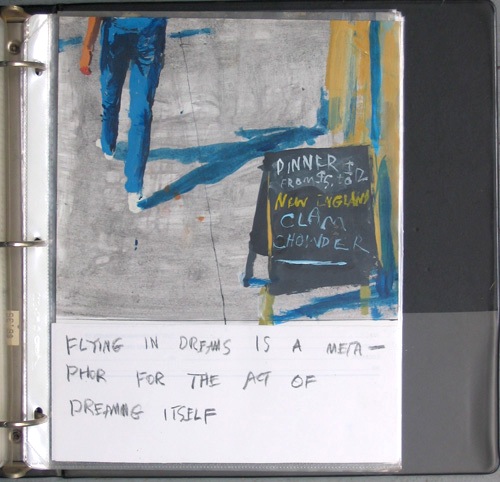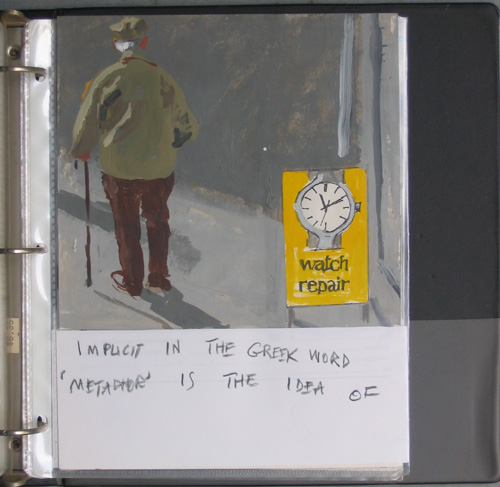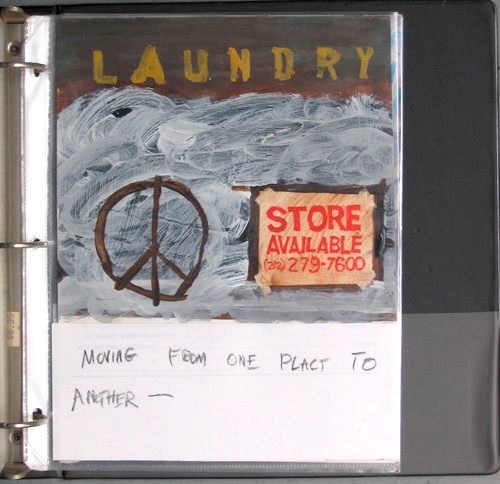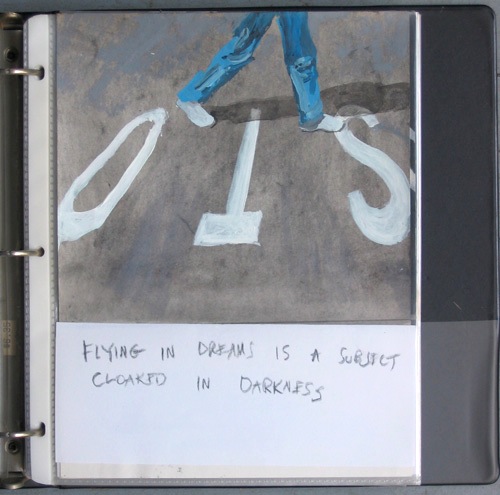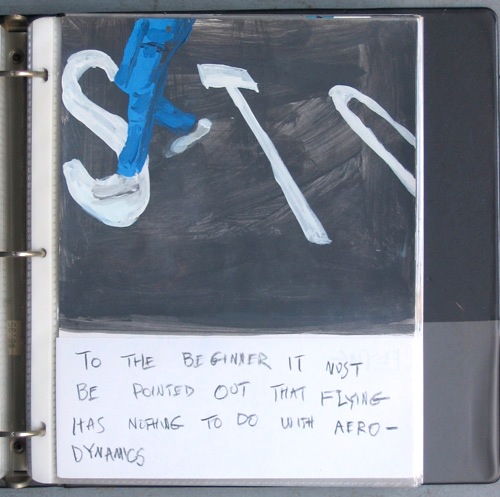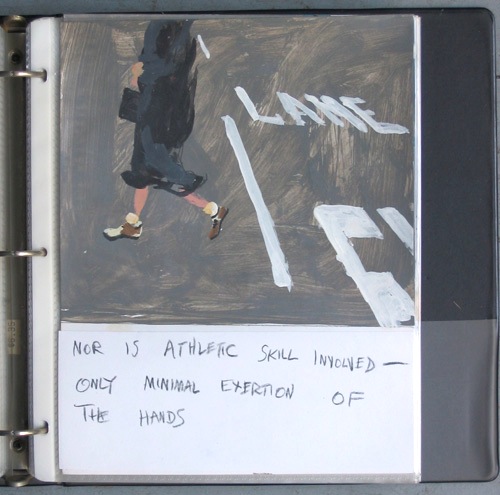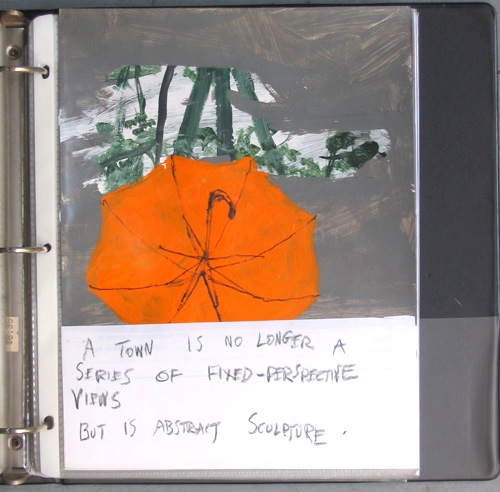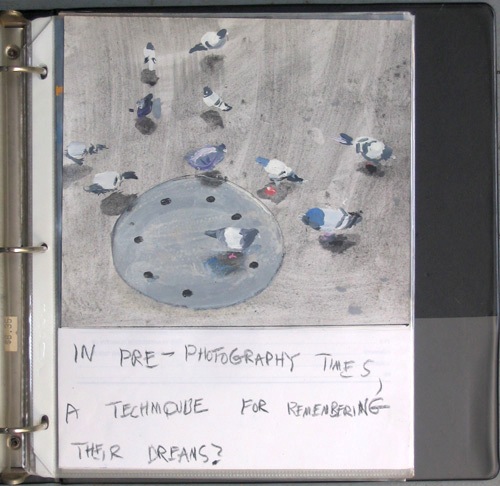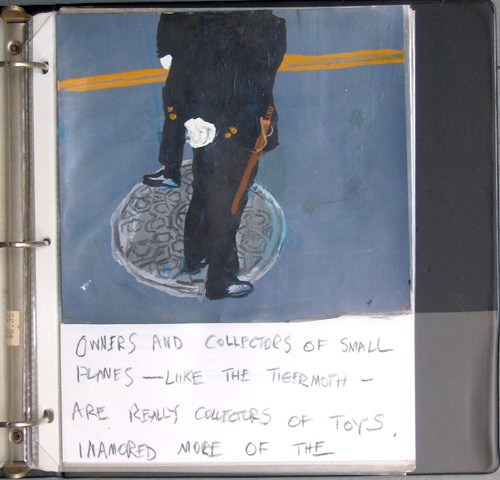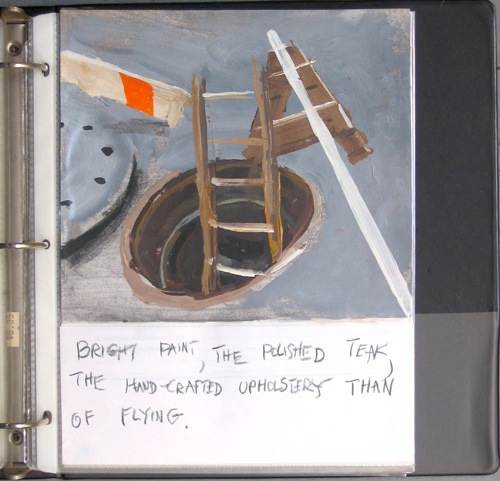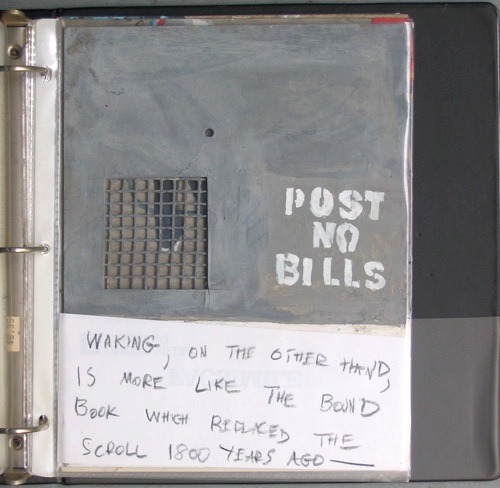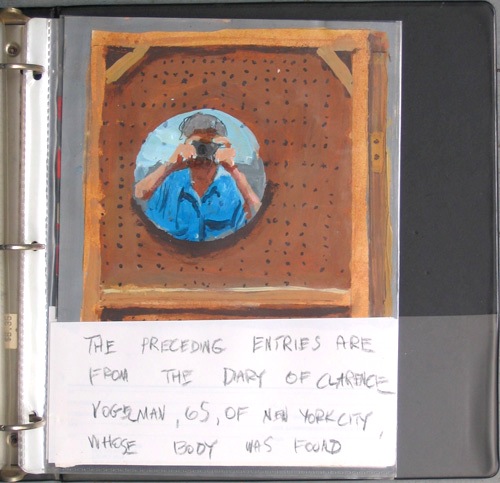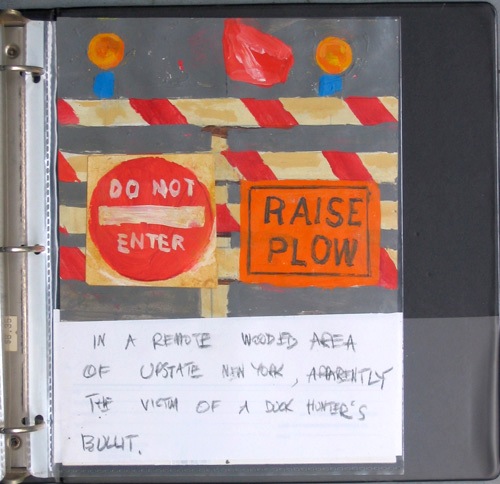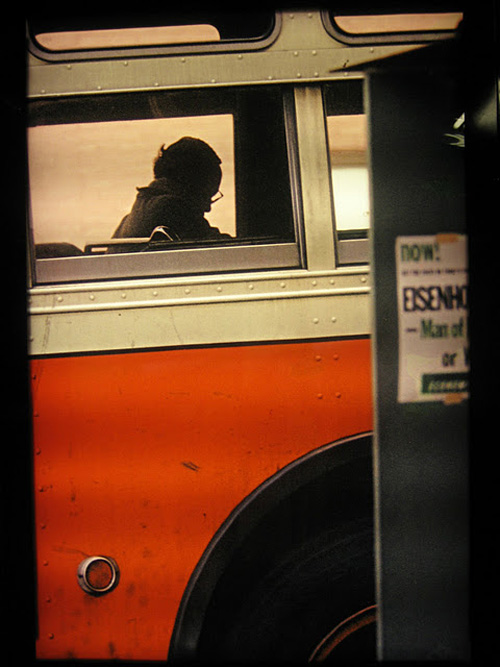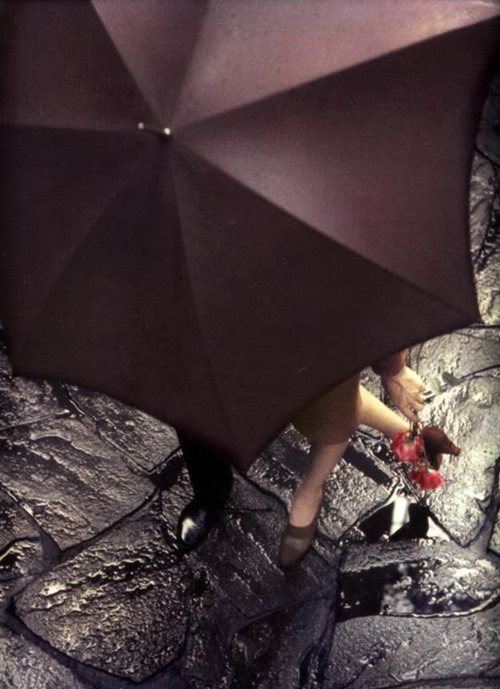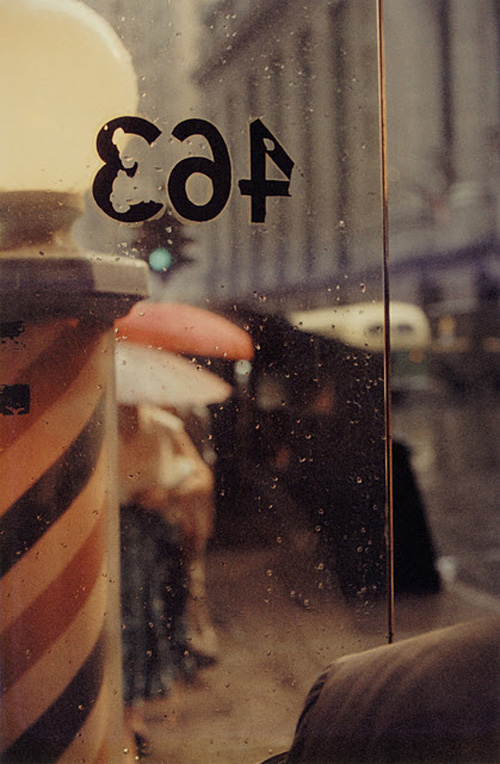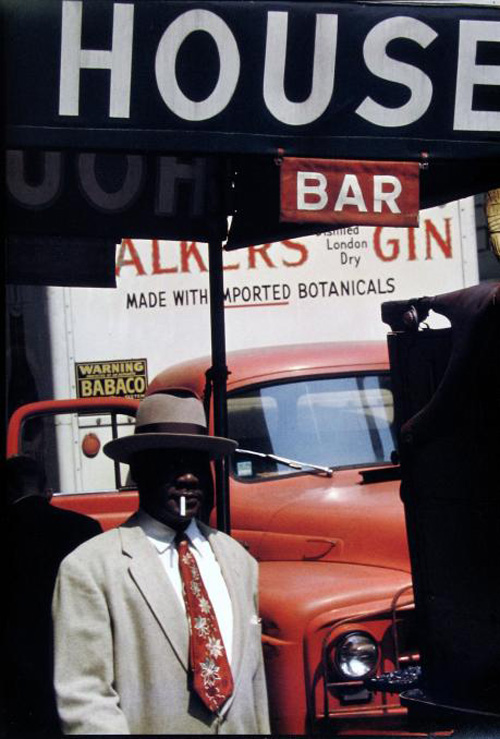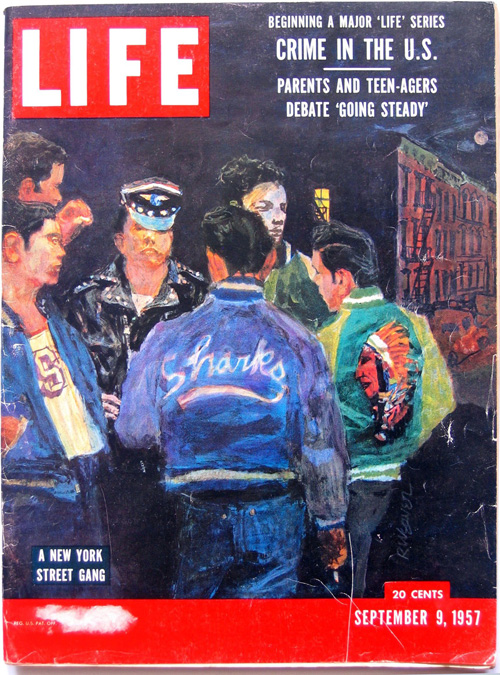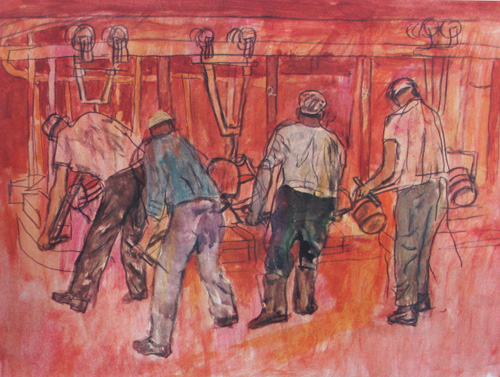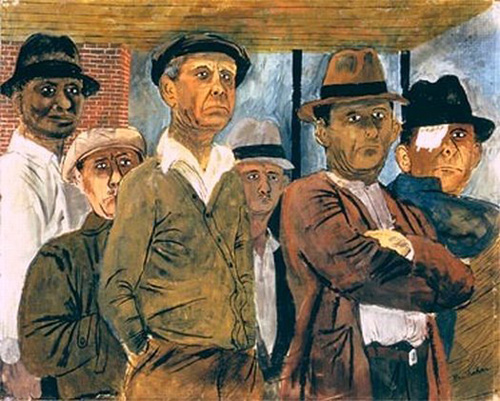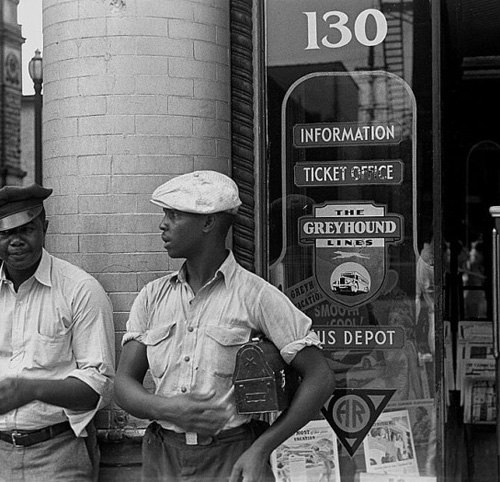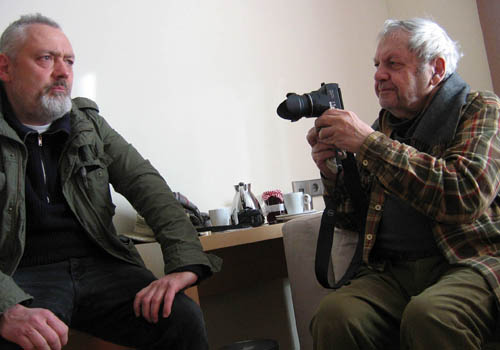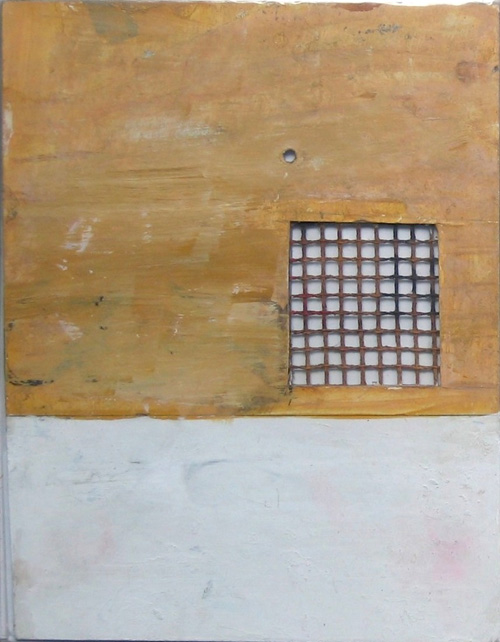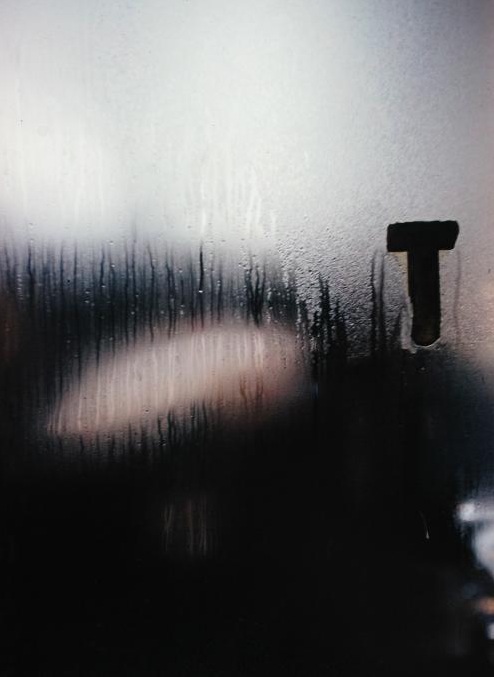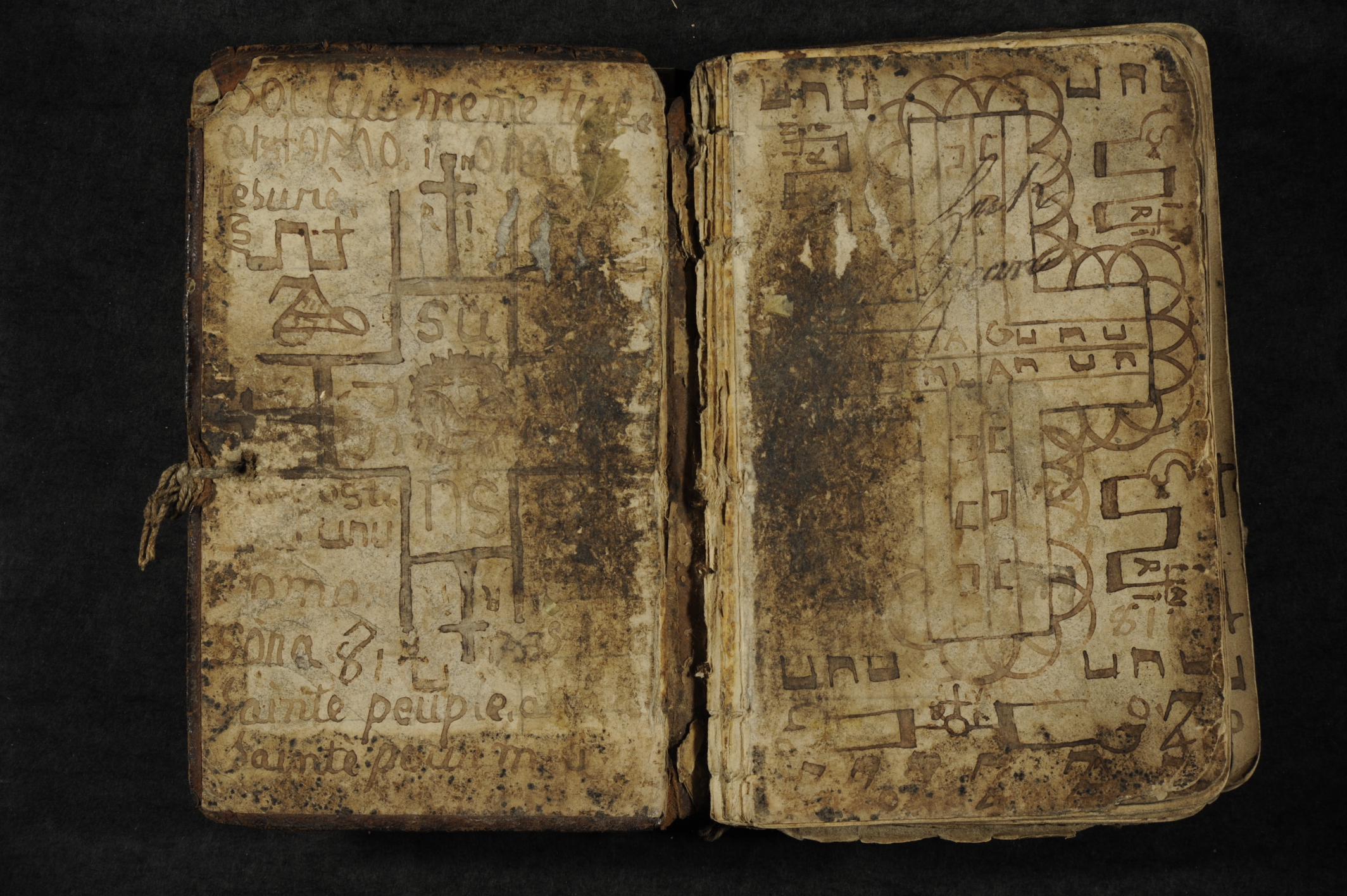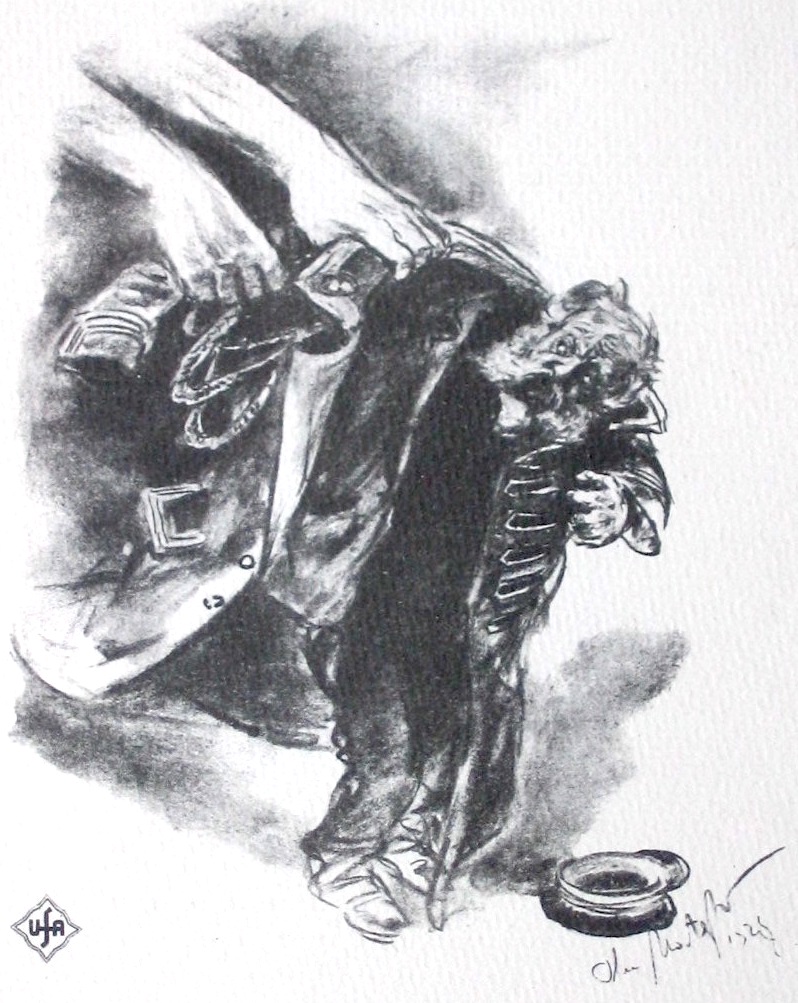Alexander Roob]
[February 12, 2012
Saul Leiter und Robert Weaver, ein künstlerischer Dialog.
„We shared a lot of ideas and we liked a lot of the same things. (…) We had quite a bit in common beside from the fact that we were friends.“ (Saul Leiter)
I: Street Scenes in Slumberland.
II: Alexander Roob in conversation with Saul Leiter.
III: Robert Weaver: The Vogelman Diary
I: Street Scenes in Slumberland
Das Opus A Pedestrian View / The Vogelman Diary von 1982 gehört zu den Schlüsselwerken des amerikanischen Künstlers Robert Weaver.(1) Es besteht aus zweiundfünfzig einzelnen Gouachen, die in Plastikhüllen in einem Ringordner abgeheftet sind. Weaver war Illustrator aus Leidenschaft und zählte seit Mitte der fünfziger Jahre zu den stilbildenden Vertretern seines Fachs. In den glamourösen achtziger Jahren, zur Entstehungszeit dieser Bilderreihe, war seine rohe und signifikante Ausdruckskunst im Erscheinungsbild der großen Illustrierten allerdings kaum mehr gefragt; Das experimentelle Spätwerk, an dem er seit Mitte der siebziger Jahre arbeitete, entstand unabhängig von allen Restriktionen oder Spekulationen einer Auftrags – oder Kunstmarktkunst in einer vollständigen künstlerischen Isolation. Jeder dieser späten Bilderzyklen, bzw. Autorenbücher repräsentiert einen neuen und überraschenden Lösungsansatz bezüglich einer Erforschung von Sequentialität im Bild, von ambulanten Wahrnehmungsweisen und multiperspektivischen Erzählstrategien; Themen, die im Kunstkontext in einer vergleichbaren Art der Durchdringung erst in den neunziger Jahren virulent wurden.
Robert Weaver, A Pedestrian View / The Vogelman Diary, 1982 (Plate 1)
Robert Weaver, A Pedestrian View / The Vogelman Diary, 1982 (Plate 2)
Robert Weaver, A Pedestrian View / The Vogelman Diary, 1982 (Plate 3)
Wie bei den meisten seiner Bildbücher operierte Weaver auch in A Pedestrian View / The Vogelman Diary mit unterschiedlichen Erzählfrequenzen. Das Besondere an diesem zweigeteilten Werk ist, daß die untere Schicht des The Vogelman Diary aus einem reinen Text besteht. Dieser wird allerdings im Verhältnis zur oberen piktoralen Ebene A Pedestrian View nicht als visuell untergeordnet wahrgenommen, denn Weaver behandelt ihn in der Entschiedenheit und Ökonomie der chirographischen Setzung als ein gleichwertiges bildnerisches Phänomen. Die obere Bildfrequenz ist ebenfalls mit einer großen Anzahl von Schriftelementen in der Form von Schildern und Aufschriften ausgestattet. Sie besteht zum überwiegenden Teil aus einer Aneinanderreihung von Straßenszenen, die, wie der Titel vermuten läßt, aus der Perspektive eines Flaneurs wahrgenommen werden.
Robert Weaver, A Pedestrian View / The Vogelman Diary, 1982 (Plate 33)
Robert Weaver, A Pedestrian View / The Vogelman Diary, 1982 (Plate 34)
Das Label „Sylvan“ (Waldbewohner), das sich auf der Abbildung eines kommunalen Müllwagens findet, referiert auf die lange Tradition des urbanen Journalismus. Der erste professionelle Großstadtflaneur Edward Cave hatte seine Londonreportagen, die zu Anfang des 18. Jhds im Gentleman´s Magazine erschienen sind, in Anspielung auf die Metapher des Grossstadtdschungels mit „Sylvanus Urban“ signiert. In Weavers Werk begegnet dem modernen Sylvanus im Alltagstreiben der Metropole eine ganze Reihe von Merkwürdigkeiten, die sich in ihrer Subtilität oft erst auf den zweiten oder dritten Blick erschließen: Eine chinesische Wäscherei beispielsweise, die in ihrem Schaufenster ein muffiges alteuropäisches Dekor ausstellt, ein Alter mit Krückstock, der in seinem gemächlichen Trott den eiligen Zeittakt, den eine Armbanduhrwerbung suggeriert, konterkariert, Passanten, die eiligen Schritts eine gebieterische Halteanweisung durchkreuzen, ein parkendes Auto, das vorgibt, in Bewegung zu sein, Millet in der Dose, Wahrsagerei aus der Fischsuppe und ein Skater, der als Falke seine Pirouetten am Asphaltfirmament dreht.
Robert Weaver, A Pedestrian View / The Vogelman Diary, 1982 (Plate 41)
Robert Weaver, A Pedestrian View / The Vogelman Diary, 1982 (Plate 47)
Robert Weaver, A Pedestrian View / The Vogelman Diary, 1982 (Plate 48)
Robert Weaver, A Pedestrian View / The Vogelman Diary, 1982 (Plate 49)
Alle Szenen in Weavers Buch scheinen in einem eigenartigen tranceartigen Schwebezustand zu verharren, ein Eindruck, der sich durch die parallele Lektüre des unteren Tagebuchlevels verstärkt. Darin geht es um die Reflexionen eines gewissen Clarence Vogelman, der sich in der Nachfolge von Theodor Storms kleinem Häwwelmann und Winsor McCays Little Nemo in einem Traumflug über die Metropole erhebt, um dann schließlich in den Wäldern von Upstate New York einen jähen Absturz zu erfahren, vermutlich, wie es heißt, durch die Kugel eines Entenjägers. Weaver bindet in Clarence Vogelmans fortlaufenden Monolog einige an Marshall McLuhan geschulte medientheoretische Überlegungen ein. McLuhans Manuskriptkultur ordnet er in der Ausprägung der chinesischen Bilderrolle die flüssige Imaginationswelt des Traumzustands zu, während das diskontinuierliche Wachbewußsein, das verstärkt dem Regiment der Sprache unterworfen ist, der Buchkultur zugeschlagen wird. Weavers Opus selbst besteht in einer Überlagerung dieser beiden Medien. Es repräsentiert weder einen kontinuierlichen Bildfluss, noch die diskontinuierliche Buchform, es balanciert in der Schwebe zwischen Traum- und Wachzustand.
Robert Weaver, A Pedestrian View / The Vogelman Diary, 1982 (Plate 10)
Robert Weaver, A Pedestrian View / The Vogelman Diary, 1982 (Plate 11)
Transgression ist das Leitmotiv von A Pedestrian View / The Vogelman Diary. Weaver verwischt die Grenzen zwischen Bild und Schrift durch permanenter Formverwandlung, nicht in der Art einer künstlichen Synthese und einer temporalen Zergliederung, wie es im Comic der Fall ist, sondern auf organische Weise, indem er ein Netz von offenen, rebusartigen Bezügen entwickelt und indem Text zum Bild mutiert und Bild Text wird. In gleichem Maß wie er den Textgehalt des Vogelman Diary in eine ausdruckstarke Bildgestalt überführt, gelingt es ihm auch den Bildgehalt des Pedestrian View in eine Metasprache zu übersetzen, die sich aus frei flottierenden Schriftzeichen zusammensetzt. Weavers enigmatisches Bildalphabet beginnt mit der Initiale A auf dem Titelblatt, die auf den folgenden Seiten zuerst zum Gestell einer polizeilichen Absperrung, dann einer Baustellenbarrikade und weiter zum Laufschritt eines Passanten mutiert und es endet auf der letzten Seite mit dem Buchstaben O in der Repräsentation eines Warnschilds: „Do Not Enter.“
Robert Weaver, A Pedestrian View / The Vogelman Diary, 1982 (Plate 12)
Robert Weaver, A Pedestrian View / The Vogelman Diary, 1982 (Plate 13)
Robert Weaver, A Pedestrian View / The Vogelman Diary, 1982 (Plate 14)
Während der Textteil mit einem Akt der Erweiterung beginnt, dem sich Fallenlassen in einen schwebenden Traumzustand, ist das piktorale Level hinten und vorne versperrt. Dem fiktiven Autor des Traumtagebuchs Clarence Vogelman ist auf der oberen Ebene der Fußgängerperspektive buchstäblich der klare Blick verstellt. Wirkliche Klärung (Clarence bzw. Clearance) erfährt er erst in der sich entfernenden Perspektive der Innenschau. Damit sich ein unverstelltes Bild von Wirklichkeit ergibt muss die beschränkte retinale Ansicht auf obertonartige Weise ergänzt werden um die Vogelfrequenz einer visionären Aufsicht und Durchsicht.
Weaver thematisiert hier auf metaphorische Weise auch den allmählichen Verlust der eigenen Sehkraft. Er litt am grünen Star und war zur Entstehungszeit des Buchs nach mehreren erfolglosen Operationen nahezu erblindet. Selbst mit Hilfe mikroskopischer Linsen war er nicht mehr in der Lage ein Buch zu lesen, – aber er konnte es malen. Der visuelle Journalismus, für den er im Illustrationsgeschäft eingestanden war, erfährt hier so wie in anderen Zyklen seines Spätwerks eine Wendung nach innen. Es geht um eine Öffnung oder Lichtung (Clearance), die sich jenseits der Barrieren der Retinalität in einem transpiktoralen metaphorischen Zwischenbereich eröffnet. Die Metapher der chinesischen Wäscherei bzw. der Reinigung, die im Pedestrian View gleich zweimal auftaucht, spielt hier hinein.
Robert Weaver, A Pedestrian View / The Vogelman Diary, 1982 (Plate 30)
Weaver war ein Bewunderer der imagistischen Dichtkunst von William Carlos Williams mit ihrem Versuch eine Bildsprache des Konkreten zu etablieren. Inspirieren ließ sich Williams dabei von Ezra Pounds ideogrammatischer Methodik, die auf einer Analyse chinesischer Schriftzeichnen beruhte. Das Verfahren von Bildfindung, das Weaver in seinem Spätwerk entwickelte war im Grund eine Anwendung dieser ideogrammatischen Methodik des Imagismus auf den perspektivischen Bildraum. Um dies zu bewerkstelligen mußte die Ebene einer fotografischen Wirklichkeit in einfachste Zeichenstrukturen zerlegt werden. Dabei kam ihm neben seiner extremen Sehbehinderung, die ihn zur malerischen Verknappung zwang, vor allem seine Analyse der Werke von Edgar Degas zu Hilfe. Degas, so Weaver in einem Interview mit Sue Gangel, habe es verstanden, auf spielerische Weise mit äußert reduzierten Bildelementen umzugehen und damit auch seine kompositorischen Entscheidungen transparent zu machen.(2) Die Bilderreihe von A Pedestrian View offenbart, wie virtuos Weaver auf dieser ideogrammatischen Klaviatur zu spielen verstand, die ihm das Beispiel von Degas und von Williams eröffnet hatte.
Robert Weaver, A Pedestrian View / The Vogelman Diary, 1982 (Plate 36)
Robert Weaver, A Pedestrian View / The Vogelman Diary, 1982 (Plate 37)
Robert Weaver, A Pedestrian View / The Vogelman Diary, 1982 (Plate 38)
Formal hatte Weaver alles daran gesetzt einen flüssigen Ablauf des Buchs zu gewährleisten, an einer Stelle jedoch kommt dieser Fluß ins Stocken. Es handelt sich dabei um ein im wahrsten Sinn sperriges Blatt, das im Gegensatz zu allen anderen beidseitig bearbeitet ist. Als Bildträger verwendete er dafür kein Papier, sondern zwei dünne Holzplatten, in die er eine von beiden Seiten einsehbare Netzstruktur eingefasst hat. Der hohe Abstraktionsgrad dieser matrixartigen Form läßt viele Deutungsmöglichkeiten zu, ein vergittertes Fenster beispielsweise, die Rasterstruktur einer Stadtlandschaft von oben, der diskontinuierliche Charakter der Buchform. All diese Assoziationen liegen auf der Hand und werden durch die Textpassagen unterstützt, sie erklären jedoch nicht die Irregualität der Arbeit. Diese begründet sich erst, wenn man darin auch eine Metapher für das vorliegende Werk selbst ausmacht, bzw. für dessen durchlässige Gewebestruktur. “Das Gewebe” (The Weave) war auch der Spitzname, den ihm seine Studenten an der School of Visual Arts verpasst hatten, und so ließe sich diese Matrixform auch ohne weiteres als ein Selbstbild des Webers dieses Werks ausmachen.(3) Diese intrinsische Intarsie, die das abstrakte Raster einer Stadtlandschaft in der Aufsicht in ein Bild von der Organisationstruktur des Werks selbst wendet korrespondiert mit der selbstreflexiven Metapher vom geträumten Flugs als ein Bild für den Traum im Traum, von dem im Vogelman Diary die Sprache ist.
Im vorletzten Blatt des Buchs schiebt sich das kreisrunde Loch, das über diesem Gewebe platziert ist, über die Matrix selbst, die nun zur Rückwand eines durchlöcherten Bildträgers mutiert ist. Der Fotograf, der darin mit der Kamera im Anschlag erscheint, könnte wiederum der Weber selbst sein. Ein Gesicht läßt sich nicht erkennen. Es ist von der Kamera verdeckt. Oder ist der Flaneurfotograf des Pedestrian View vielleicht noch ein Anderer, eine Person, auf die in einem weiteren Blatt Bezug genommen wird auf der eine Leiter abgebildet ist? Sie ragt aus dem Rund eines Kanalrohrs empor.
Robert Weaver, A Pedestrian View / The Vogelman Diary, 1982 (Plate 43)
Robert Weaver, A Pedestrian View / The Vogelman Diary, 1982 (Plate 51)
Robert Weaver, A Pedestrian View / The Vogelman Diary, 1982 (Plate 52)
Der Künstler Saul Leiter, ein enger Freund Weavers, hatte Ende der vierziger Jahre begonnen auf dem Feld der Farbfotografie zu experimentieren. Weaver war einer der wenigen Zeugen, die die Entwicklung von Leiters markanten Strassenfotografien seit den frühen fünfziger Jahren mitverfolgt haben. Durch die spezifische Farbigkeit, die subtilen Perspektiven und die flächigen malerischen Bildausschnitte stellt sich in Leiters Straßenbildern ein ganz ähnliches Gefühl von Entrücktheit und Unwirklichkeit ein wie in Weavers Fußgängerszenen. In einem Beitrag des Magazins Color Photography. A Popular Photography Annual mit dem Titel Saul Leiter´s Dream World wurde dieser halluzinogene Aspekt von Leiters fotografischer Flaneurtätigkeit bereits 1960 thematisiert.(4) Der Dialog, der sich zwischen beiden Künstlern entsponnen hat betraf nicht nur verwandte Kompositionsschemata und ein große Schnittmenge aus kunsthistorischen Referenzen, sondern vor allem einen spezifischen Modus, das urbane Umfeld als ein kaleidoskopartiges Enigma wahrzunehmen. Leiters fotografisches Werk war eine Hintergrundsfolie, vor der Weaver sein metaphorisches Zeichensystem entwickeln konnte.
Während Weavers Arbeit, auch sein unabhängiges Spätwerk, im Kunstkontext nie eine Resonsanz gefunden hatte, waren Beispiele von Saul Leiters frühen fotografischen Arbeiten u.a. im Tokyo Museum (1953) und im Museum of Modern Art in New York (1953/1958) zu sehen. Danach sind sie lange in Vergessenheit geraten. „Leiter is a young man not in a hurry“ hieß es 1960 in dem Beitrag Saul Leiter´s Dream World und tatsächlich traten seine Arbeiten erst vier Dekaden später erneut ins Rampenlicht des Kunstbetriebs. Seither wird sein Werk in einer Reihe von wichtigen internationalen Ausstellungen und Publikationen als ein substantieller künstlerischen Beitrag zur Fotografiegeschichte des 20. Jhds gewürdigt. (A.R.)
Anmerkungen
1) Das Buch befindet sich in der Sammlung des MePri. Im November dieses Jahres wird es erstmals komplett in einer Ausstellung des Heidelberger Kunstvereins zu sehen sein.
3) > Alexander Roob: The Weave. Die Lehren des Robert Weaver. In: Elke Bippus, Michael Glasmeier hrsg.: Künstler in der Lehre. Hamburg 2007
4) „One man´s dream is another man´s reality. To almost everyone who sees the photographs of Saul Leiter, they convey a sense of mystery, of the hidden or the undiscovered; the images strike a responsive chord somewhere in the unconscious. They are pictures not readily described or discussed, but deeply felt. If they make us say “unreal” or “weird”, that may only reflect our own misunderstanding of the “real”. For Leiter these are images of actuality, drawn from the most significant layers of awareness, seen in the truest perspectives.(…) Saul Leiter is a young man not in a hurry.“ (H.M. Kinzer, Saul Leiter´s Dream World, in: Color Photography, 1960, S. 46)
Saul Leiter, Bus, New York 1954
Saul Leiter, Shoe Advertisement for Miller Shoes, 1957
II: On Robert Weaver. Alexander Roob in conversation with Saul Leiter.
Alexander Roob: Thank you very much for your willingness to provide informations about your friend Robert Weaver who died in 1994.
Saul Leiter: At first I was shocked, then I was surprised, then I was very, very pleased when I heard what is happening to Bob´s work, that it is being cherished and taken care of and being admired. I´m very happy that it survived, and interests people and will be appreciated more and more. It could so easily have remained in storage and been forgotten. I used to talk to him sometimes about the fact that his work was very fragile and could very easily been damaged if it was not taken care of. Things quite often are thrown away and people are forgotten.
Bob was the typ of being an unusual artist. He was one of the very best friends I ever had and my affection for him was very special. I hated to see him suffer but I admired the fact that under the most difficult circumstances he managed to be productive. We occasionally talked about the operation on his eye which damaged the eye and it was almost heroic how he continued to work – In this late period of my life I have become a little bit known and people come and ask me all kinds of questions and I got to the point where I hate being interviewed. (Laughing) I make a great exception for Bob Weaver. I tell you it is very nice when you spend your life doing things to have certain things admired and to be lucky enough to be alive when it happens, you see ? I wish that Bob had the experience of living longer. He died as I recall of pancreatic cancer and it seems to have happened very quickly with him
Saul Leiter, 463, 1956
Saul Leiter, Harlem, 1960
A.R.: You both were almost the same age and you both came from the same city, from Pittsburgh, but obviously with very different preconditions. When you started experimenting with photography and abstract painting in New York, Weaver was in Venice practicing frescoe technique and studying Renaissance painting and contemporary Neorealism. Can you tell us how you met?
S.L.: We didn´t meet in Pittsburgh. I think it was Bobby Zelnick who brought him one day over to my apartment in New York. I don´t know exactly when. Zelnick came also from Pittsburgh. He was a realist painter at that time and I believe he has studied with Bob.
A.R.: I presume you met shortly after Weaver came back from his studies in Italy. He settled in New York in 1950.
S.L: Yes, maybe. Later, in 1959 we both went to Europe together. I had an assignment to photograph Gina Lollobrigida in the bathtub but she didn´t want to be photographed. Then I think we went to Rome where we saw Philip Pearlstein, who was a friend and then we went to Venice and I met his aunts and we stayed there a little bit and then we came back.
A.R.: Did you follow the development of his late experimental work, this body of narrative pictorial books?
S.L.: When I knew him he showed certain things to me which I admired very much. But he didn´t, at least with me, spend time discussing the work or talking about it or explaining it. He never talked with me about his work so much. He knew that I admired him and I thought of him. I even used to joke with him and tell him that, when he would be an illustrator, he could be actually a fine art – artist. We would laugh about that and of course at that time he was more interested in being an illustrator, even though his paintings were quite beautiful. The things he did for Life magazine were quite remarkable and it was a great pity that they were not kept together.
Robert Weaver, Cover for Life Magazine, September 1957
AR.: You both worked in the commercial sector and you both were successful in bringing a fresh experimental and artistic spirit into the applied arts, into fashion photography and the illustration business.
S.L: He, I think was much better at it than I was. He was considered being very unusual by people who cared about illustration and in fact he was among the most unusual people in the field, to put it mildly. I had never been involved in the world of illustration as I have in the world of painting. I told him he had a greater destiny to fulfill. (laughing) He loved illustration, he loved the whole work, he loved dealing with the problems. He had no trouble enjoying the work he did. He was not apologetic about it. He was not like those people who are doing something and wish that they could do something else. Bob was not that way.
A.R.: So for him illustration apparently seemed to be an end in itself, the final aim of his art. But on the other end I heard that from the late Seventies on he had less and less commercial work to do, because he was considered by a new generation of art directors as being difficult to work with.
S.L.: I didn´t know the problems that he had with work. I went to see Henry Wolf at Esquire, because Bob has worked for it and Bob wanted me to see Henry, and Henry was of course a great admirer of Bob´s work. If he had difficulties I did not know what was going on. If so, he was probably right and the people who had difficulties with him were probably wrong.
Robert Weaver, Fortune Magazine, November 1957
A.R.: Can you speak about the role of art directors like Henry Wolf of Esquire or Leon Lionni of Fortune Magazine ?
S.L.: I can´t speak of everybody, but of Henry. He became a very good friend of mine. Henry held Bob Weaver for a superb artist. But I don´t know that Henry knew about Bob´s later work. I´m not sure about that.
A.R.: Obviously Weaver´s late uncommercial work was only known by a very small circle.
S.L: This is probably true.
A.R.: In another interview you mentioned that Weaver belonged to the very few people who visited your private slide shows in the Fifties and who accordingly were aware of your early color street photography.
SL: I would from time to time get new boxes of slides and project them. Bob would come over and clap. Dottie (Dorothy Weaver) would also be there.
A.R.: Did Weaver share your artistic enthusiasm with photography? Do you know if he created a photo-archive of his own?
S.L.: Later on Bob did beautiful work which must be somewhere. He had a Roleiflex.
A.R.: I perceive a lot of parallels betweet your painterly way of photography and some of his illustrations and especially of some of his late pictorial books.
S.L.: We shared a lot of ideas and we liked a lot of the same things. At the time for instance he liked Ben Shahn, I liked Ben Shahn. I think we liked certain ways of framing things and organizing them. I think we had quite a bit in common beside from the fact that we were friends.
A.R.: You mention Ben Shahn, this last dinosaur of American social realism, as a common person of reference. Wasn´t it rather precarious in the phobic McCarthy era to work in this spirit of the socio-critical leftist WPA-tradition and of a self-confessed communist like Shahn? Can you recall political discussions with Weaver at that time?
S.L.: I admired some of Ben Shahn’s things but I think Shahn meant more to Bob. I can’t comment on McCarthy. I was not concerned with McCarthy’s issues. As a person Bob was conservative, but what did he feel about McCarthy? Bob´s father was a kind of crank. He had a radio show in Pittsburgh and once criticized women wearing high heels.
Ben Shahn, Unemployed, 1938
Ben Shahn, Bus station, Ohio. 1938
A.R.: The legend of modernism glorifies this shift that took place in the early Fifties from the long tradition of American social realism to the abstractions of the New York School as an abrupt and radical break. But your work and also Weaver´s work seem to be a convincing example of the continuity and coalescence of both traditions.
S.L.: Well, that may be true. Regardless of what kind of painting I might have done myself I was always very interested in all kinds of things. I never thought it gently that because there was a movement of one kind that the other kind of work had no place in the scheme of things. I was aware for example of the work of Otto Dix or of Balthus. So I was never overcome by the notion that simply because some people did abstractions that the other thing was dead.
A.R.: I was always curious to learn more about the relations between Weaver and the most popular artist from Pittsburgh, who was five years younger…
S.L.: You are talking about Andy Warhol? Bob used to get annoyed with Andy Warhol and the whole idea that he had conquered the world. I used to say to him that there is not very much you can do if someone wants to buy an Andy Warhol. He was very critical of him.
A.R: But in the beginnig there must have been some closer connections between Weaver and Warhol. They both were competitors in the same segment of illustration business and for some time they also shared the same manager, Dick Bahm and both were following in Ben Shahn´s footsteps at that time.
S.L.: I remember, and I forgot this: I took pictures of Andy Warhol with his mother one day. Bob took me to meet Andy Warhol and in that early period Andy Warhol was a great admirer of Bob Weaver. I remember that Bob brought some work up to Warhol´s house and he was looking at it carefully and I took some pictures of him. But in my photographs you don´t see anything clearly. You cant´t see that he is looking at Bob Weaver´s work. But I know that he talked about him with great admiration. That was before he became famous.
A.R.: It would be interesting to learn more about the artistic enviroment in which he was involved at the time you knew him. Was it rather limited to colleagues from the graphic-design field or more open? You already mentioned two painters, Robert Zelnick and Phil Pearlstein.
S.L: He was friendly with commercial people but he sometimes attended Tanager openings and met De Koonig, Pollock and David Smith. (Note: The Tanager Gallery operated from 1952 – 1962 in the Lower East Side as a cooperative outlet predominantly for abstract expressionists like Saul Leiter but also for some figurative painters like Philip Pearlstein and early Pop artists like Alex Katz or Tom Wesselmann.)
A.R.: Do you know why he never showed his work in an exhibition? Was it because of ideological or conceptual reasons?
S.L.: He would have liked to have an exhibition. I thought he deserved it but I was not in the position to arrange to have anything. There was a store window where people used to have shows of their work, I believe it was on Broadway and 11th or 12th street. And very often when we went by he said he would love to have his work shown there; but he never had it. I don´t know why. Bob was not traditionally the kind of artist who had exhibitions.
A.R.: What do you mean by that ?
SL.: He simply was more interested in being an illustrator than he was in being a fine artist – whatever that means.
A.R.: Most of Weaver´s ideas revolved around temporal qualities, sequentiality and simultanity and not so much around spatial representation. Maybe that´s another reason.
S.L.: Yes, I know he was involved in certain ideas. I´m not an expert on everything he did later. I thought his ideas where interesting. He deserved to be known.
A.R.: Don´t you think it strange or funny that also after the experiences of Pop Art and the influence of cultural studies, art history still seems to constitute and legitimize itself mainly by a fundamental separation between high and low, that is by ignoring the major impulses deriving from commercial arts and other popular „low“ sectors?
S.L.: You think there is too much of a separation? It maybe. As far as I´m concerned I´ve been very often impressed by certain commercial people who do quite unusual things. You see, I don´t think life is fair and many things who deserve attention don´t get it and some things have too much attention. For instance, I saw occasionally in an auction catalogue a beautiful unusual illustration by Juan Gris when he was quite young, quite superb, very, very good. I never heard that he did those kind of things. Than I heard also Franz Kline used to make illustrations. Someone could do a very interesting show about the early work of certain fine artists, when they were doing commercial things. Could be an interesting show, don´t you think?
AR: Of course. – Juan Gris used to work together with other artists like Frantisek Kupka or Felix Vallotton for the French satire magazine L´assiette au beurre. To Weaver this magazine represented a major example of his ideal of an artistic and autonomous mode of illustration. Moreover, he deduced his self-confidence as an illustrator from the insight that American fine art was substantially founded on illustration business, from Winslow Homer on.
S.L.: The trouble with art history is: They take ideas and divide things up and when someone comes along who does not fit in their categories, then they don´t know where to put him and sometimes instead of putting him, they forget him and ignore him. The history of art is full of ups and downs. So when I heard that Bob Weaver is remembered I was very delighted. – Don´t you think life is very strange, that we sit here and talk about Bob?
(December 17, 2011 / February 3, 2012)
Alexander Roob – Saul Leiter (photo: Lena Roob)
IT IS AS EASY TO DO /
AS IT IS TO SAY.
————————–
DREAMING BEGINS WITH /
THE ACT OF FALLING.
————————————-
IN DREAMS IT IS ONLY THE /
FEAR OF FALLING THAT /
PREVENTS YOU FROM FLYING. /
YOU STAND AT ROOFEDGE /
YOU DO NOT LOOK DOWN IN
PANIC /
AND YOU CAST YOURSELF INTO /
WELCOMING AIR.
——————————————
THE WILLING SUSPENSION OF I . /
IT IS NOT A MATTER OF /
MASTERY BUT RATHER OF /
SURRENDER
—————————————
FLYING IS PASTORAL – EXPRESSING /
PERHAPS A LONGING FOR/
REUNIFICATION WITH THE PRE-/
HISTORIC LANDSCAPE.
—————————————
IT IS IMAGINATION OVER PRAC- /
TICALITY. SPIRIT OVER FLESH.
—————————————-
THE BEST TIME TO TELL /
STORIES TO CHILDREN IS WITH /
THE LIGHTS OUT.
——————————
THE SCENERY IS MORE /
COLORFUL ON RADIO THAN ON T.V. /
TALES ARE BEST ILLUSTRATED /
IN THE HEAD.
———————————
IF THERE WERE NO UN-/
SOLVED MYSTERIES – THERE /
WOULD NO LONGER BE A /
NEED FOR ART.
——————————–
FLYING IN DREAMS IS A SUBJECT /
CLOAKED IN DARKNESS
—————————–
TO THE BEGINNER IT MUST /
BE POINTED OUT THAT FLYING /
HAS NOTHING TO DO WITH AERO- /
DYNAMICS
———————————–
NOR IS ATHLETIC SKILL INVOLVED – /
ONLY MINIMAL EXERTION OF /
THE HANDS
—————————————-
WEIGHTLESNESS, LIKE INVISIBILIY, /
IS AN IMPOSSIBILITY TRANS- /
FORMED INTO FACT.
—————————————–
ANGELS DO NOT NEED WINGS
—–
MUHAMMAD ALI TELLS THE STORY /
OF THE AIRLINE ATTENDANT WHO /
ASKED HIM TO FASTEN
—————————————–
HIS SEAT BELT. “SUPERMAN DONT /
NEED NO SEATBELT,” HE ANNOUNCED. /
“SUPERMAN DONT NEED NO /
AIRPLANES, NEITHER.” WAS THE REPLY.
———————————————
WORDS LIKE `LIFT`, `BUOYANCY´, /
`UPDRAFT´ ETC., EXPERIENCED IN /
THE SEAT OF THE PANTS BY EARLY /
AVEATORS ARE IRRELEVANT.
——————————————-
THE KIND OF FLYING UNDER /
DISCUSSION HERE IS FLYING MINUS /
THE GRAVITY FACTOR.
——————————————
IN THE WAKING MIND´S EYE, LAUNCH- /
ING ONES SELF FROM A ROOFTOP /
MUST INEVITABLY BE FOLLOWED /
BY UPRUSHING UNSTOPPABLE GROUND-
————————————–
WITH ONLY THE INVENTION OF /
SOME FORM OF TECHNOLOGY TO /
SPARE US A MESSY CONCLUSION.
———————————-
FLYING IN DREAMS, LIKE DREAMING /
ITSELF, IS UNREGULATED, UN- /
CHARTERED AND UNSHEDULED /
AND THEREFOR –
————————————-
IS ILLEGAL AND TO BE DIS- /
MISSED OUT OF MIND. THE /
MIND TURNS A BLIND EYE ON /
THIS FLOUTING OF PHYSICS.
———————————-
YOU BEGIN YOUR SAIL ACROSS /
TOWN, IGNORING ITS GRID OVER /
TARBEACH SUNBATHERS, CLOGGED /
TRAFFIC ARTERIES, AFTERNOON BASEBALL
————————————–
STAYING CLEAR, OF COURSE, /
OF AIRPORTS. FURTHER OUT /
YOU SWIM OVER WALLED – IN /
ESTATE GROUNDS AND THEIR /
ASTONISHED SLEAZY BARKING DOGS
—————————————–
– AND PRISON YARDS, HIGH-SECURITY /
WEAPONS PLANTS, AND GAME PRESERVES.
——————————————-
SET DOWN UPON THE FAMILIAR /
CARTOGRAPHIC ARRANGEMENTS OF /
EXPRESSWAYS, RIVERS, RAILROADS AND
——————————————–
BORDERLINES IS AN OVERLAY /
OF NEW CONNECTIONS, RANDOM CRISS- /
CROSSING RESEMBLING A CHILDS
———————————————-
DRAWING, WHAT ONCE WAS A /
MAP TURNS INTO ABSTRACT ART- /
AN AFGHAN WAR CARPET WHOSE /
STORIES NO LONGER MATTER
———————————————
A TOWN IS NO LONGER A /
SERIES OF FIXED-PERSPECTIVE /
VIEWS /
BUT IS ABSTRACT SCULPTURE.
——————————————
YES, IT IS A HELICOPTER RIDE –
BUT WITHOUT THE EAR-SHATTERING /
RACKET. /
THE DREAMING FLYER
——————————————–
CASTS NO SHADOW AND PRO- /
DUCES NO ENGINE NOISE.
LIKE THE BALOONIST
————————————–
HE CAN HEAR, DISTILLED, COMING /
UP FROM THE GROUND, THE SOUNDS /
THE WORLD MAKES.
—————————————
ARTISTS DREW AERIAL VIEWS OF /
CITIES AND TOWNS LONG BE- /
FORE THE INVENTION OF BALOONS.
————————————-
IS IT SO IMPROBABLE THAT /
THEY DID NOT SO MUCH IMAGINE/
THEM AS THEY DEVELOPED,
——————————————
IN PRE-PHOTOGRAPHY TIMES, /
A TECHNIQUE FOR REMEMBERING /
THEIR DREAMS?
—————————————-
OWNERS AND COLLECTORS OF SMALL /
PLANES – LIKE THE TIGERMOTH – /
ARE REALLLY COLLECTORS OF TOYS. /
INAMORED MORE OF THE
—————————————–
BRIGHT PAINT, THE POLISHED TEAK, /
THE HAND-CRAFTED UPHOLSTERY THAN /
OF FLYING.
——————————————-
IT IS NOT THE FELLOWSHIP OF /
OWLS AND FALCONS ONE JOINS, /
NOR THAT OF GULLS OR DUCKS –
——————————————-
FOR THE SOLO SOJOURNER IT /
IS FLIGHT ITSELF – NOT /
HUNTING OR ARRIVING AND DE- /
PARTING – THA IS THE LURE.
—————————————–
DREAMING IS CONTINUOUS- LIKE /
THE UNROLLING OF A /
CHINESE LANDSCAPE SCROLL –
—————————————-
VISUAL, SPATIAL, MOVIE LIKE.
—————————————–
WAKING, ON THE OTHER HAND, /
IS MORE LIKE THE BOUND /
BOOK WHICH REPLACED THE /
SCROLL 1800 YEARS AGO –
——————————————
THAT IS – DISCONTINUOUS, VERBAL /
MORE EFFECIENT AND REQUIR- /
ING LESS HAND EXERTION
————————————–
THE SCROLL (DREAMING) DIFFERS /
FROM A MOVIE, HOWEVER, IN THAT /
IT IS PRIVATE AND VIEWER-CONTROLLED
—————————————–
FLYING IN DREAMS IS A META- /
PHOR FOR THE ACT OF /
DREAMING ITSELF
——————————————–
IMPLICIT IN THE GREEK WORD /
´METAPHOR´IS THE IDEA OF
——————————————-
MOVING FROM ONE PLACE TO /
ANOTHER –
—————————————–
WITHOUT BARRIERS.
————————————
THE PRECEDING ENTRIES ARE /
FROM THE DIARY OF CLARENCE /
VOGELMAN, 65, OF NEW YORK CITY, /
WHOSE BODY WAS FOUND
Robert Weaver, A Pedestrian View / The Vogelman Diary, 1982 (Plate 44)
Saul Leiter, ‘T’ (1950)
